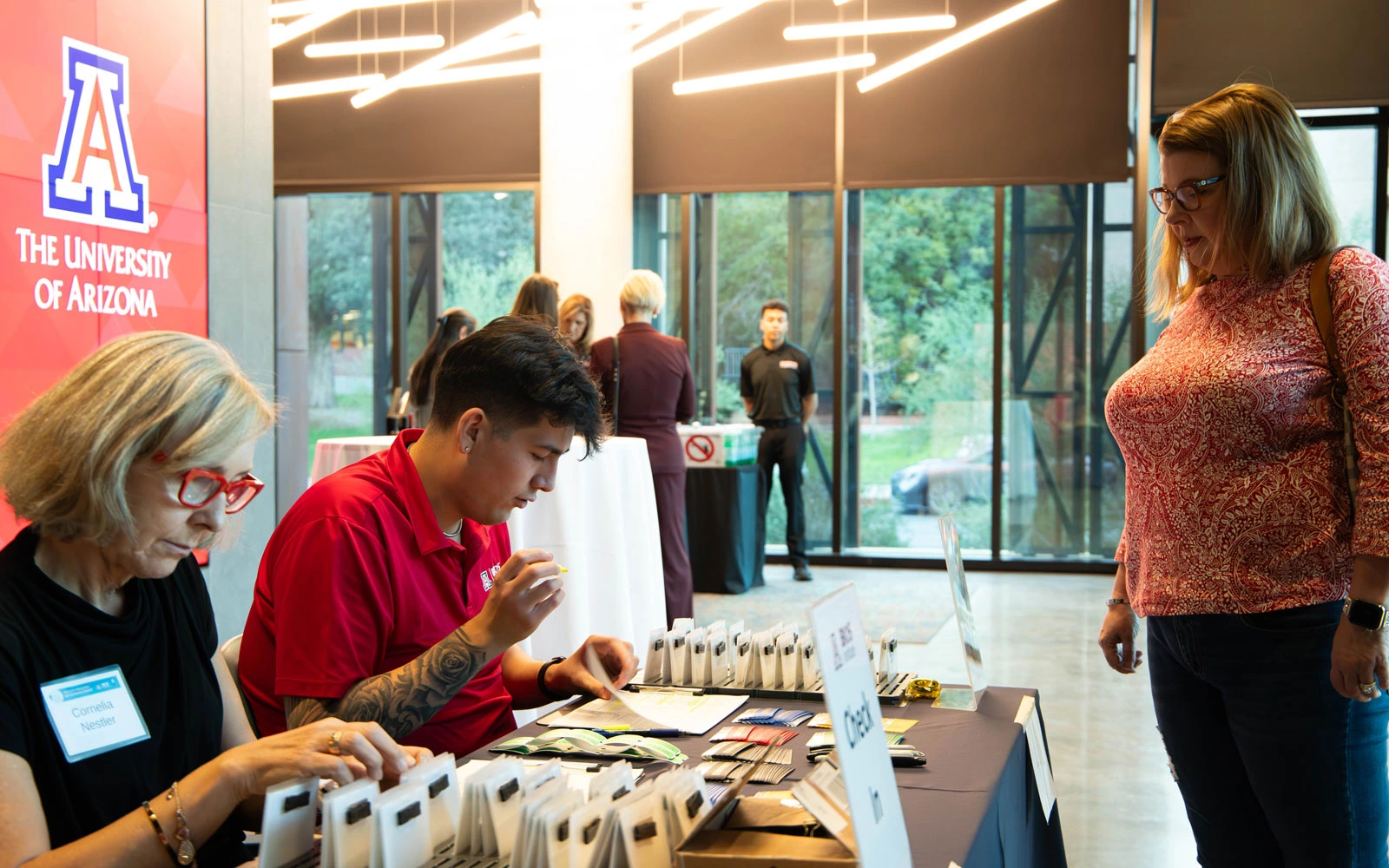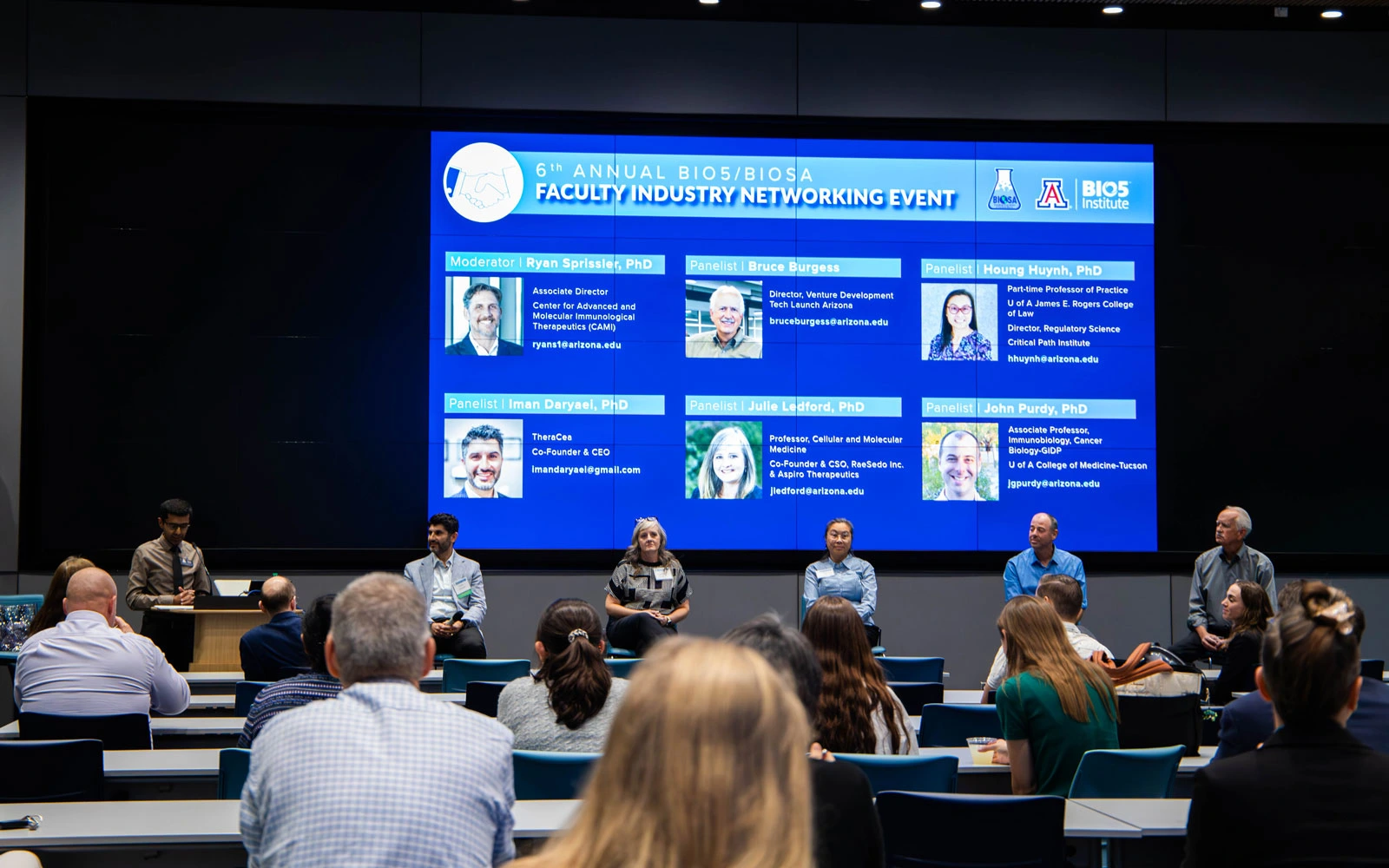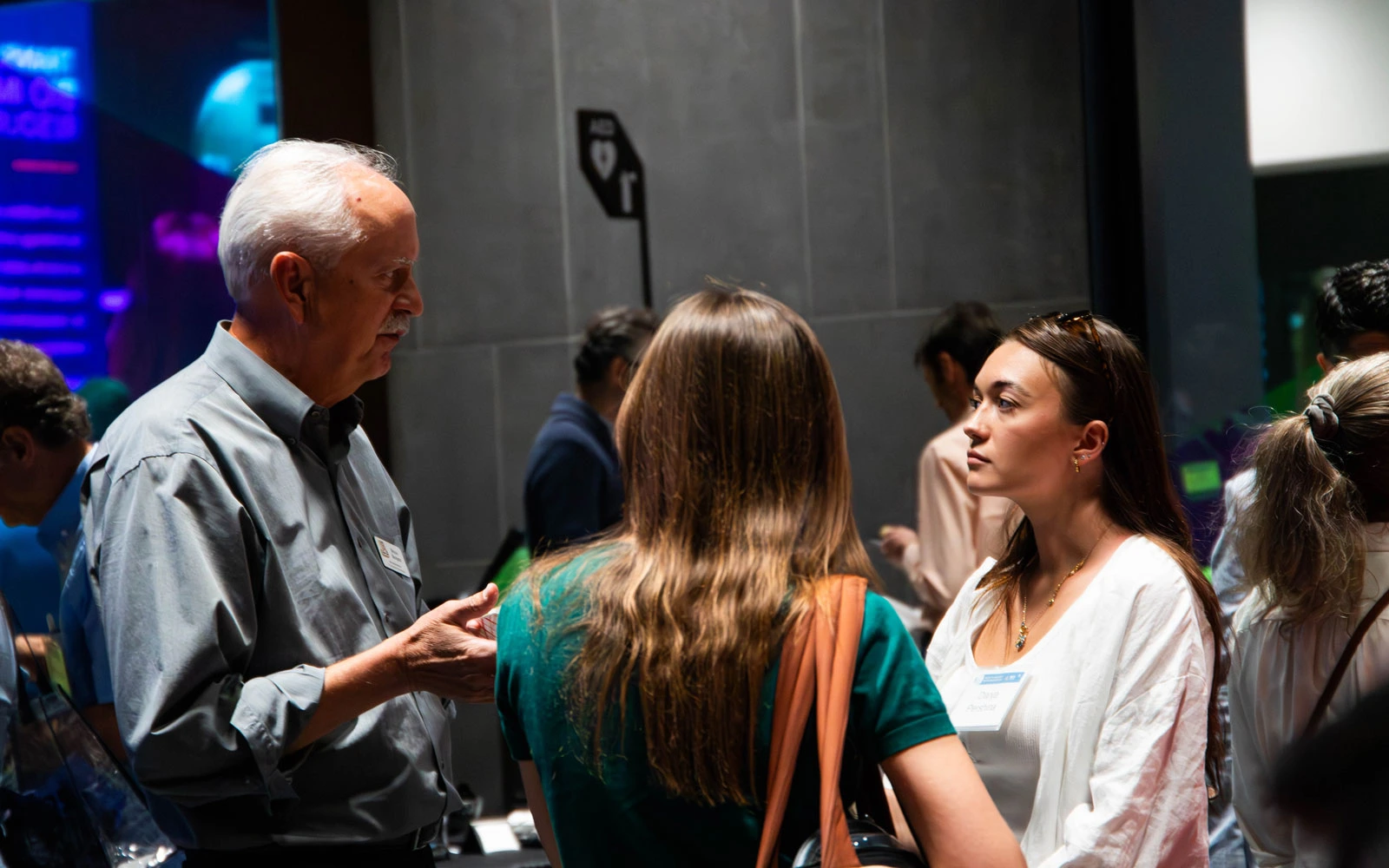Lessons in partnership from the 2025 Faculty Industry Networking Event
At the sixth annual event hosted by the BIO5 Institute and BIOSA, a new panel highlighted clear communication, thoughtful partnership structures, and student preparation as essential elements of successful university–industry collaboration.
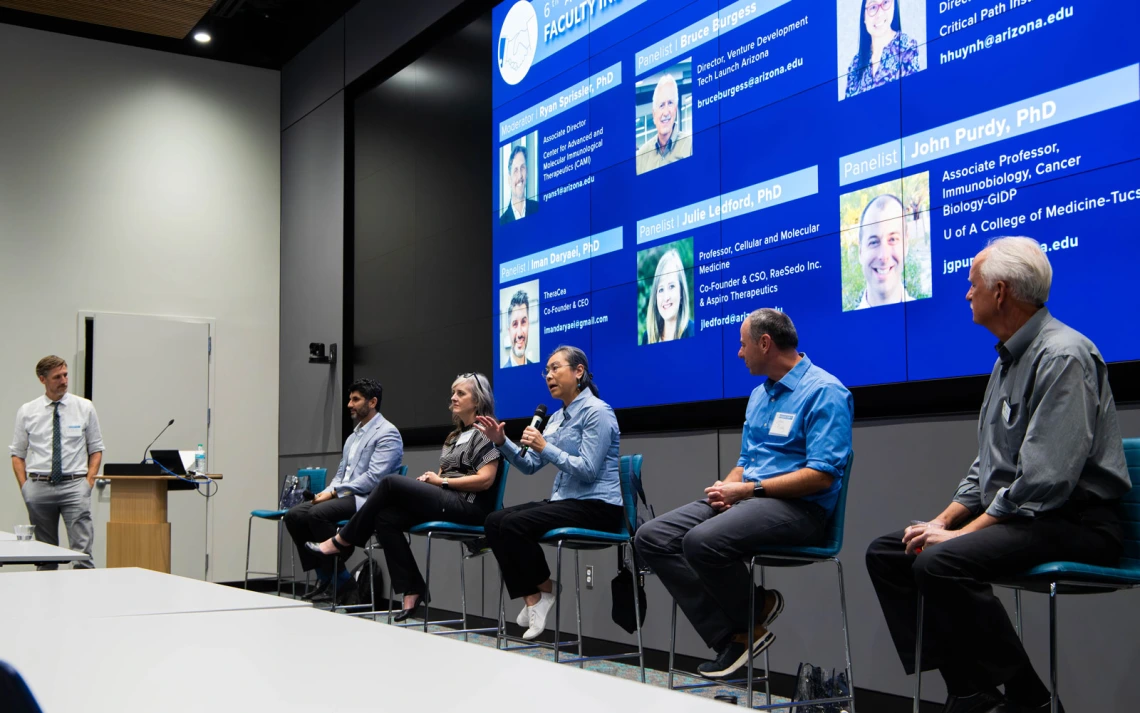
Five panelists from University of Arizona faculty to industry leaders shared their practical approaches to university-industry collaboration at the 6th annual Faculty Industry Networking Event held at the Grand Challenges Building on the University of Arizona Tucson campus.
Lily Howe, BIO5 Institute
More than 55 faculty, researchers, community members, and industry professionals gathered for the Faculty Industry Networking Event (FINE), hosted by the BIO5 Institute and the Bioindustry Organization of Southern Arizona (BIOSA).
The annual event, now in its sixth year, connects innovators across life sciences, medicine, engineering, and computing to explore how ideas can move more efficiently from research to real-world impact.
“Partnerships are the heart of the Office of Research & Partnerships at the University of Arizona,” said Jason Wertheim, associate vice president for research and partnerships – health research and BIO5 member. “When faculty and industry come together, we see tangible outcomes: new technologies, patents, startups, sponsored research projects, and internships that prepare the next generation of scientists and engineers.”
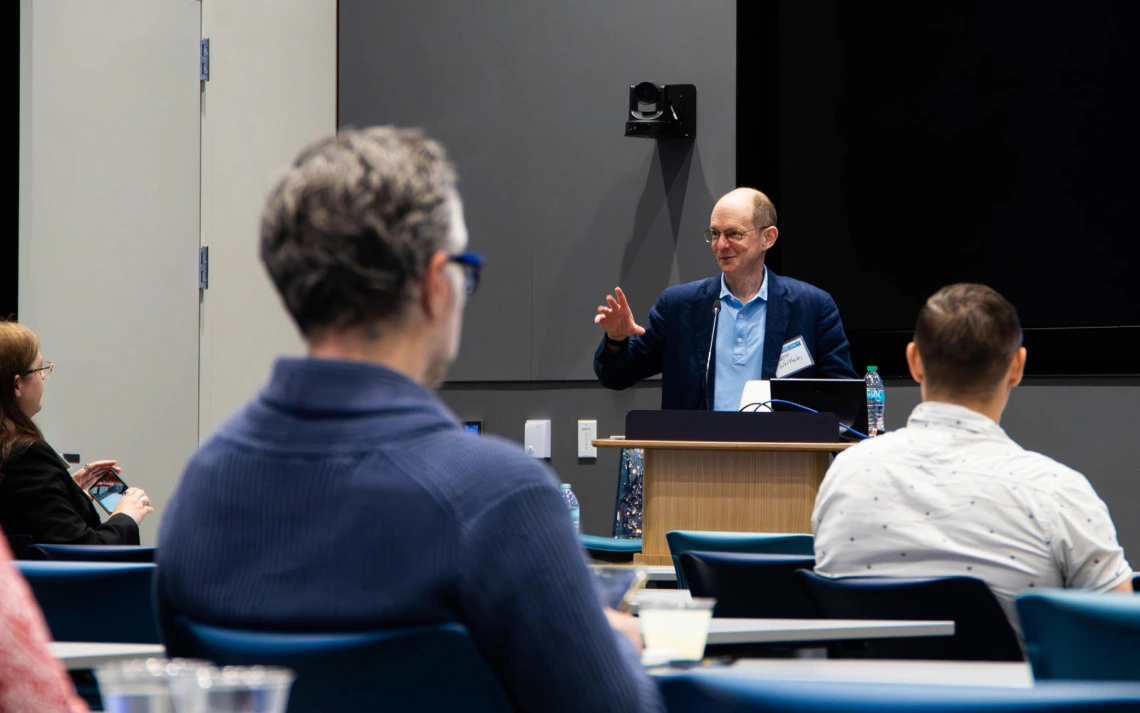
Jason Wertheim from the University of Arizona Office of Research & Partnerships discussed the importance of partnerships between industry and researchers.
Lily Howe, BIO5 Institute
This year’s program introduced a new feature — a panel discussion moderated by Ryan Sprissler, associate director of the Center for Advanced and Molecular Immunological Therapeutics at the University of Arizona.
The conversation at the Grand Challenges Building on the University of Arizona Tucson campus brought together university researchers and Arizona biotech leaders to share practical approaches to communication, collaboration, and navigating shared challenges.
Panelists reflected on what makes university–industry partnerships effective and sustainable. Their discussion centered on three main themes: defining clear roles and communication, navigating research ownership and institutional processes, and preparing students for success in the biotech workforce.
Setting clear roles and building trust
Julie Ledford, co-director of the Clinical Translational Sciences Graduate Program and associate director of translational research at the Asthma & Airways Disease Research Center at the University of Arizona College of Medicine – Tucson, spoke about lessons learned from her own experience leading both academic and entrepreneurial efforts.
“You have to be very clear about what your university lab is working on versus what your company is doing outside the university,” said Ledford, a BIO5 member. “It’s important to know when to bring in partners with business experience who can help take your innovation further.”

Julie Ledford, University of Arizona faculty, is the co-founder of two companies, RaeSedo, Inc. and Aspiro Therapeutics.
Lily Howe, BIO5 Institute
John Purdy, associate professor of immunobiology and cancer biology at the University of Arizona College of Medicine – Tucson, added that clarity in expectations helps him stay focused on the science itself.
“When I consult or serve on a scientific board, it’s a different kind of collaboration,” said Purdy, a BIO5 member. “It’s rewarding to share expertise and talk about the science without having to make decisions. What matters most is being clear about their expectations of me — and mine of them — from the start.”
Balancing research ownership and real-world demands
Bruce Burgess, director of venture development at Tech Launch Arizona, spoke about the importance of establishing clear ownership of research outcomes when entering into industry partnerships.
“Before industry comes in, it’s crucial to have worked with TLA and the invention disclosure process,” said Burgess. “That’s how we protect the research you’ve done and ensure fair agreements for all involved.”

Bruce Burgess at Tech Launch Arizona provides the people and resources to ensure that University of Arizona startups are properly equipped with the connections, tools, and expertise to launch a successful company.
Lily Howe, BIO5 Institute
Iman Daryaei, co-founder and CEO of TheraCea, shared the perspective of a startup leader who frequently collaborates with academic researchers.
"Without the University as a resource and supporter, it would be very difficult—if not impossible—to advance a biotech venture in southern Arizona,” said Daryaei. “However, there are areas where improvements are needed in how collaborations and partnerships begin, develop, and conclude. Even simple agreements can take months to finalize. Understanding the University’s structure helps both sides set realistic expectations."
Both emphasized that transparency, clear documentation, and an understanding of each institution’s process are key to building sustainable, mutually beneficial partnerships.
Preparing students for industry success
Huong Huynh, director of regulatory science at the Critical Path Institute and part-time professor of practice at the James E. Rogers College of Law at the University of Arizona, highlighted how internships and early research experiences help students bridge academic learning with industry application.
“Internships open doors for students to understand clinical trial data and the real-world side of research,” said Huynh. “When students gain that experience, they can become part of the workforce at the university or local startups—it comes full circle.”
After the panel, attendees stayed to network, exchange ideas, and explore potential collaborations. Conversations focused on shared challenges, complementary expertise, and how to make partnerships more effective and inclusive.

